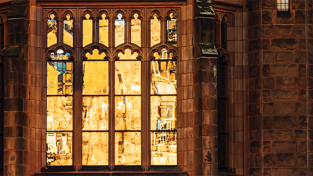Change in Time
Mount Holyoke leads the way with the most inclusive policy on transgender admission among its Seven Sisters peers
“We typically think of women as the minority, but when it flips—when a trans student has that role—all sorts of weird stuff happens,” says Cade Friedenbach ’13. Friedenbach was born female, but the summer before he enrolled at Mount Holyoke, he began to understand that he no longer identified with his assigned gender. At a loss for what that meant, he identified as genderless and began going by the name Cade while still using female pronouns. By the end of his first year, Friedenbach came out as a transman and switched to male pronouns. “I’d always known myself well. I just needed the words,” he says.
At that time, in the spring of 2010, Friedenbach knew of only one or two other people on campus using male pronouns, which made each of them “infamous,” he says. But, for Friedenbach, even more difficult than explaining the language around his identity was transitioning to make his body match his gender.
I’d always known myself well. I just needed the words.
Cade Friedenbach ’13
“As a transgender person on the Mount Holyoke campus, I had to go through a second puberty in college,” he says. “I had to learn how to shave in a women’s restroom. And when I walked around at night, people made phone calls because I was the suspicious man on campus.”
But still, Freidenbach chose to remain at Mount Holyoke and complete his education at a women’s college. In his own community—in the dorms and classrooms and the student groups that he was active with—he found the support and safety that are central to the Mount Holyoke experience.
During her 2014 convocation address to the College community, President Lynn Pasquerella ’80 announced that Mount Holyoke had formally established a policy around the admission of transgender students.
“We recognize that what it means to be a woman is not static,” an emotional Pasquerella said at the ceremony before an amphitheater full of students and community members, many of whom cheered loudly at the announcement. “Just as early feminists argued that reducing women to their biological functions was a foundation of women’s oppression, we acknowledge that gender identity is not reducible to the body,” said Pasquerella. “And we are mindful that exclusion from the category of ‘woman’ based on contingent properties of birth is nothing new.”
The admission policy—officially in place as the class of 2019 submitted their applications to the College—defines membership in a women’s college expansively, to be as inclusive as it can with respect to gender identity, while still fulfilling Mount Holyoke’s historic mission as a liberal arts college for women dedicated to academic excellence.
The announcement came at a time when women’s colleges were being called upon to articulate their policies with respect to the admission of transgender students. About a month earlier Mills College became the first women’s college to announce a policy. Mount Holyoke set itself apart by being the first of the original Seven Sisters to formalize a policy, one that was also the most inclusive at the time, offering admission to “any qualified student who is female or identifies as a woman.” Among the policies since put in place at women’s colleges including Smith, Barnard, Wellesley, and Bryn Mawr, only Simmons College, led by President Helen Gannon Drinan ’69, has put in place a policy equally inclusive as Mount Holyoke’s.
Jen Jack Gieseking ’99 is an urban cultural geographer whose research focuses on “co-productions of space and identity . . . with a focus on sexual and gender identities.” Gieseking’s first book, The People, Place, and Space Reader, was published in 2014 and is a collection of writings brought together “to make sense of the ways we shape and inhabit our world,” he says.
“The best thing about going to Mount Holyoke,” he says, “is that even if class isn’t focused on gender, you’ll be looking at gender all the time. Patriarchy is introduced.”
As a student Gieseking identified as lesbian. He first came out as trans to the Mount Holyoke community in a class note in the winter 2013 Alumnae Quarterly.
“I’m transgender, non-op, and non-hormone,” he wrote. “I go by Jen or Jack and use either pronoun that makes grammatical sense—after all, once an MHC student, always an MHC alum in matters of grammar and gender.”
Alumnae who read Gieseking’s update reached out. They emailed. They asked about pronouns. Connections with new friends opened up. And in 2014, Gieseking attended his class’s fifteenth reunion, returning to campus for the first time since publicly identifying as trans.
“Classmates and alums were really out-of-the-way supportive,” Gieseking says. “I love MHC so much because I don’t know if I would have felt so safe and loved and beautiful anywhere else.”
About seven years before the Mount Holyoke trans policy was put in place, the visibility of trans men on campus caused a stir among some alumnae. The Boston Globe magazine published an article, “When She Graduates as He,” in April 2007 about Kevin Murphy ’08, a Mount Holyoke student who took testosterone and underwent gender reassignment surgery while attending the College. The discovery didn’t sit well with some. Alumnae wrote in to the Alumnae Quarterly, and while it’s not the current policy of the magazine to accept letters that don’t pertain to content published in the magazine, the “Viewpoints” section became a forum of discussion of the issue. Alumnae weighed in on both sides.
I love MHC so much because I don’t know if I would have felt so safe and loved and beautiful anywhere else.
Jen Jack Gieseking ’99
In the years since that Boston Globe article the transgender community has become more visible beyond academia and gender studies. While the term transgender began to be more widely used after the 1996 publication of Transgender Warrior by the late writer and activist Leslie Feinberg—whose work also has been credited for establishing a serious discipline of gender studies—it took decades more for the trans community to gain larger visibility.
In June 2014 Time magazine featured on its cover the transgender actor Laverne Cox. President Obama included the transgender community in his January 2015 State of the Union speech. And in September 2015 the Amazon.com television program Transparent, about an adult male transitioning to female, won five Emmy awards in its first season. More recently the public transition of Caitlyn Jenner—former Olympic gold medalist and reality TV star Bruce Jenner—has brought even more focus to the transgender community.
Still, the civil rights of the trans community are not protected in thirty-eight states. As the Quarterly was going to press, trans rights were making news in several states nationwide. In December, in the case of a trans student athlete in Illinois who had filed a complaint after being denied full access to high school locker rooms, the US Department of Education Office for Civil Rights mandated that the school district provide access to the locker rooms, including private changing stations. In November, in Houston, Texas, voters defeated a proposed referendum on the city’s anti-discrimination ordinance that would have banned discrimination based on sexual orientation and gender identity.
An April 2015 survey by the Human Rights Campaign, the nation’s largest lesbian, gay, bisexual, and transgender civil rights organization, revealed that the number of likely American voters who say they personally know or work with a transgender person is 22 percent, up from 19 percent in 2014. Still, transgender people are frequently victims of violence, and the statistics tell a grim tale. The year 2015 was the most violent on record, according to the National Coalition of Anti-Violence Programs, which reported in November that there were twenty-two homicides of trans people in 2015, compared with twelve in 2014 and thirteen in 2013. And according to a survey conducted by the National Center for Transgender Equality and the National Lesbian Gay Bisexual Transgender Queer (LGBTQ) Task Force, 41 percent of transgender people have attempted suicide.
In October 2014, the New York Times Magazine cover story was “Men of Wellesley: Can women’s colleges survive the transgender movement?” Quoted in the article, President Pasquerella spoke of the reasoning behind Mount Holyoke’s far-reaching policy in terms of civil rights. It’s the same message she shared during convocation: “We need a formal policy . . . that articulates our core values of individual freedom, social justice, and diversity and inclusion.”
The impetus for the policy was a legal case brought against George Fox University, a top-ranked Christian college in Oregon. In 2013 a transgender student was denied a change in housing, which had always been single-sex in accordance with the institution’s religious ethos. The case started a national conversation around the civil rights of transgender students. Part of that conversation happened at Mount Holyoke, and within a year, after months of detailed meetings with staff, board members, and students, President Pasquerella addressed the community.
Just as early feminists argued that reducing women to their biological functions was a foundation of women’s oppression, we acknowledge that gender identity is not reducible to the body.
Lynn Pasquerella ’80
The College’s policy guarantees that transgender students are given the same rights as every other student. Their applications are handled no differently, housing assignments only consider sleep and study habits for pairing roommates, and the College offers the same opportunity to compete in athletics in compliance with NCAA policies. Trans students, like all Mount Holyoke undergraduates, also have access to peer health educators and referrals to community health care providers, who understand the nuances of hormonal and surgical transition. And if a trans student legally changes his or her name, Mount Holyoke will make those changes to diplomas and other college records.
Since the policy was introduced, many students and alumnae have voiced their opinions and asked important questions about what it means for Mount Holyoke.
During the two reunion weekends last May, the Alumnae Association hosted a panel titled “The Transgender Conversation Continuum” to give alumnae a forum for learning about the policy and the opportunity to ask any questions they may have. Before one panel began, a mother expressed her concerns to President Pasquerella about her daughter being in the same bathroom as men and trans women.
“She said, ‘It’s not about your daughter or other [cisgender] students—this is about protecting the minority students, not the majority,’” says Friedenbach, who was on the panel. “That set the tone for everyone else.”
The questions raised during each panel were thoughtful, and sometimes provocative.
“How do you propose we create a safe space for trans men at institutions that have historically ‘empowered’ women for centuries?” “If we are gender inclusive, aren’t we becoming co-ed?” “What sort of structural inclusive changes are you offering to current and future gender non-conforming students, (i.e., living learning centers, dedicated staff advocates, etc.)?”
“What is the classroom experience?” several people wanted to know.
“How does a person who was born a biological female and transitioned to a male end up at a women’s college?” says KC Haydon ’00, assistant professor of psychology and education and one of the panelists at the reunion sessions.
“My students have talked about that one quite a bit. They’ll talk about the false dichotomy that we perceive in our species that isn’t there. Biology is not straightforward, and then you layer on the complexity of human identity and psychology. Just because a student identifies as a male when they’re twenty years old, they still had twenty years of being socialized as a woman. That’s why the policy is so consistent with our identity as a women’s college,” Haydon says.
Her best insight came from one of her students who is a transman: “He asked me ‘What better place for me than a women’s college? People understand gender dysphoria, they work for change, they’re ready to have conversations, and I want to be a part of that.’”
Biology is not straightforward, and then you layer on the complexity of human identity and psychology.
KC Haydon ’00
“Issues of identity and inequality are important aspects of belonging, and in order to create an inclusive learning community, it is critical that all members of the community feel safe and secure,” says Dean of Students Marcella Runell Hall, who also was a panelist during Reunion and one of the officers involved in the discussions that led to the development of the College’s policy. “Acknowledging and affirming people’s identities is certainly one key aspect of this. In more than fifteen years working in higher education, I have been aware of students identifying their pronouns and choosing non-binary pronouns to describe their gender identities. As people of all ages feel more comfortable to identify outside of the gender binary, this is likely to continue.”
In the nearly three years since Friedenbach graduated, the transgender movement has grown—at Mount Holyoke, on other campuses nationwide, and beyond the higher education landscape.
“This is the next movement,” says Gieseking. “[Identifying as trans] doesn’t mean you’re going to get surgery or change your name. There is not a script. It’s about accepting all people.”
And while there is a policy that now formally recognizes them, transgender students have in fact been an active and accepted part of the Mount Holyoke student body for years. According to a recent student survey by the College, about 0.5 percent of Mount Holyoke’s student body, or ten students at any given time, identify as transgender, a statistic that is slightly higher than the 0.3 percent estimated number of trans people in the US, according to a 2011 study by UCLA School of Law’s Williams Institute.
Mount Holyoke is also a community that fosters inclusiveness. The College is already a safe place for the queer community, with several student groups for LGBTQ students. In November the Mount Holyoke News reported that the College was ranked one of the country’s “12 Best Colleges for Queer Women” by SheWired, an online magazine for women “gay, straight, and in-between.”
What’s nice about MHC is that being in a segregated space, you get to see how many types of women there are. It doesn’t espouse the idealized version of femininity—there’s freedom in defining who you are.
Elliot Ruggles ’06
“I feel very proud about my experience in my role as a woman in this world,” says Elliot Ruggles ’06, a transman who now runs the Gender and Sexuality Resource Center at the State University of New York in Oneonta. “What’s nice about MHC is that being in a segregated space, you get to see how many types of women there are. It doesn’t espouse the idealized version of femininity—there’s freedom in defining who you are.”
“We know how complicating it is to be a woman,” says Gieseking. “How much change needs to happen. I wouldn’t have the strength or capacity to fight for change if I hadn’t become such a feminist.”
Most students at the height of their college careers are striving to do the work that undergraduates have always done—meet deadlines, make grades, solidify a next step beyond their bachelor’s degree. For Mount Holyoke students—all Mount Holyoke students—that work is grounded in their education at a women’s institution, an education that demands that they be aware of needed change. And, like so many remarkable Mount Holyoke students and alums before them, that they be at the forefront of making that change.
—By Rachel Sturtz
With additional reporting by Jennifer Grow ’94
Rachel Sturtz is a freelance writer living in Denver. She writes for many publications, including Outside, Marie Claire, and Popular Mechanics.
This article appeared in the winter 2016 issue of the Alumnae Quarterly.
January 15, 2016











Leave a Reply